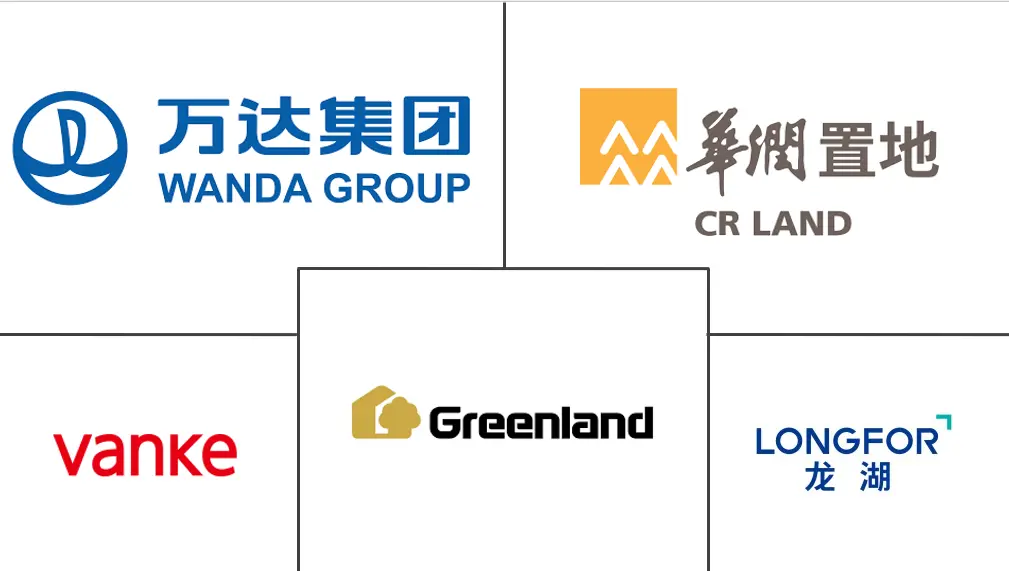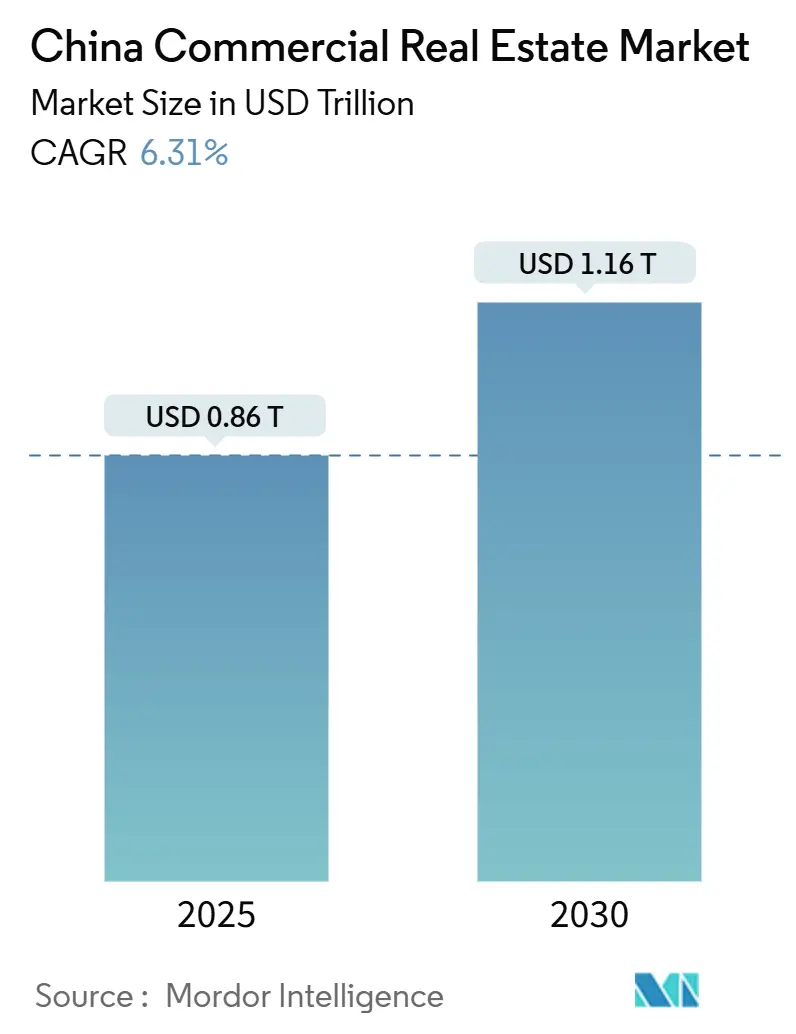
China Commercial Real Estate Market Analysis by Mordor Intelligence
The China commercial real estate market stood at USD 0.86 trillion in 2025 and is forecast to reach USD 1.16 trillion by 2030, expanding at a 6.31% CAGR. Momentum stems from a USD 563.4 billion public-funding push for housing and urban projects, the rollout of infrastructure real-estate investment trusts (C-REITs), and a policy tilt that favors asset upgrades over green-field additions. Occupier needs keep shifting toward modern logistics space, Grade-A offices, and data-driven campuses, while institutional investors intensify their hunt for stabilized yields in a volatile financing climate. At the same time, legacy stock oversupply, high private-developer borrowing costs, and the slow absorption of secondary malls curb headline growth. Competitive advantage is drifting away from scale-oriented developers toward asset-light operators able to combine patient capital with technology-enabled property management.
Key Report Takeaways
- By property type, office led with 34.0% share of China commercial real estate market in 2024; logistics properties are projected to register the fastest 7.72% CAGR to 2030.
- By business model, the sales controlled 62.0% share of China commercial real estate market in 2024, while rental operations are forecast to grow at a 6.98% CAGR through 2030.
- By end-user, corporate and SME accounted for 66.1% share of China commercial real estate market in 2024; individual investors represent the quickest-expanding cohort at a 6.73% CAGR through 2030.
- By city, Shanghai captured a 22.0% share of China commercial real estate market 2024, whereas Chengdu is on track for the highest 7.24% CAGR by 2030.
China Commercial Real Estate Market Trends and Insights
Drivers Impact Analysis
| Driver | ( ~ ) % Impact on CAGR Forecast | Geographic Relevance | Impact Timeline |
|---|---|---|---|
| Resilient logistics demand from e-commerce & dual-circulation policy | +1.8% | National, tier-1 logistics hubs | Medium term (2-4 years) |
| State-led urban-renewal stimulus for Grade-A office upgrades | +1.2% | Shanghai, Beijing, Shenzhen, Guangzhou | Short term (≤ 2 years) |
| Accelerated C-REIT program unlocking institutional capital | +0.9% | National, early gains in Shanghai, Beijing, Shenzhen | Long term (≥ 4 years) |
| “New quality productive forces” agenda for data-center & life-science campuses | +0.7% | Tier-1 cities and tech corridors | Long term (≥ 4 years) |
| Transport-hub buildout catalyzing last-mile warehousing | +0.5% | Chengdu and emerging transport centers | Medium term (2-4 years) |
| Net-zero & 3-Star green-building mandates | +0.4% | National, strictest in tier-1 cities | Medium term (2-4 years) |
| Source: Mordor Intelligence | |||
Resilient Logistics Demand from E-commerce & “Dual-Circulation” Policy
China’s dual-circulation blueprint emphasizes domestic consumption alongside external trade, which lifts the logistics backbone of the China commercial real estate market. Average warehouse occupancy already exceeds 90% in Greater Beijing and Shanghai, while prime rents in Beijing have risen 90% since 2008. E-commerce giants accelerate investments in automated distribution and last-mile nodes that meet tight delivery promises to consumers. Government guidelines for supply-chain modernization dovetail with private capital inflows to class-A logistics parks, driving sustained absorption even as export growth moderates. The resulting logistics pipeline is capital-intensive, favoring long-lease assets that appeal to pension funds and insurance firms. Stable rental escalations reinforce the segment’s perception as quasi-infrastructure within the China commercial real estate market.
State-Led Urban-Renewal Stimulus for Grade-A Office Upgrades in Tier-1 Cities
Central and municipal authorities earmarked USD 197.2 billion for 5,392 urban-renewal projects by August 2024, targeting stock optimization rather than new supply.[1]State Council — “Five Departments Jointly Voice Their Opinions on the Continuous Promotion of Urban Renewal Initiatives,” metal.com Within Shanghai, Beijing, Shenzhen, and Guangzhou, redevelopment priorities include smarter HVAC systems, flexible floorplates, and carbon-reduction retrofits to satisfy hybrid-work tenants. Public policy banks have been instructed to prioritize renewal loans, lowering execution risk for qualified schemes. The focus on quality lifts demand for Grade-A space, even as secondary offices struggle with high vacancy. Developers able to reposition older assets can capture rental premiums while easing the structural oversupply that weighs on the broader China commercial real estate market.
Accelerated C-REIT Program Unlocking Institutional Capital for Infrastructure-type CRE
The China Securities Regulatory Commission has cleared warehouse, industrial-park, and consumer-infrastructure assets for public listing, marking a structural shift away from debt-heavy development toward equity-funded ownership vehicles. Sinotrans filed for a warehouse REIT on the Shanghai exchange in January 2025, spotlighting fresh liquidity channels for logistics portfolios. Inclusion of PRC REITs in Stock Connect broadens foreign access and potentially lowers the cost of capital across the China commercial real estate market. Stable dividend policies appeal to insurers and pension funds, who can now recycle capital into long-dated assets without balance-sheet stress. The cascading benefit is a healthier funding environment that rewards owners focused on steady income streams.
“New Quality Productive Forces” Agenda Spurring Data-Center & Life-Science Campuses
Policy documents framing China’s next-generation productivity highlight digital infrastructure and biosciences as national priorities. Demand for hyperscale data centers escalates as cloud-services penetration deepens, while pharmaceutical clusters require GMP-compliant labs. These specialized formats demand high-capex builds and sophisticated power or HVAC specifications that traditional developers rarely master. Institutional investors co-invest with operators to secure pipeline access and spread technical risk. In turn, long lease tenures and mission-critical occupancies underpin stable returns, enriching the income profile of the wider China commercial real estate market.
Restraints Impact Analysis
| Restraint | ( ~ ) % Impact on CAGR Forecast | Geographic Relevance | Impact Timeline |
|---|---|---|---|
| Structural oversupply of legacy office stock post-hybrid adoption | -1.4% | Tier-1 office cores | Short term (≤ 2 years) |
| High financing costs for private developers amid sector deleveraging | -1.1% | National, sharpest for smaller firms | Medium term (2-4 years) |
| Elevated vacancies in lower-tier malls | -0.8% | Tier-2 and tier-3 trade areas | Medium term (2-4 years) |
| Land-sale revenue caps constraining new-build pipelines | -0.6% | Nationwide, varied implementation | Long term (≥ 4 years) |
| Source: Mordor Intelligence | |||
Structural Oversupply of Legacy Office Stock Post-Hybrid Adoption
Hybrid work has trimmed aggregate office-space needs, exposing functional deficiencies in pre-2010 towers lacking flexible layouts or modern ventilation. Research shows that each unit rise in pandemic-related sentiment pushed rents down 8% in high-vacancy cities. Grade-A conversions benefit from renewal subsidies, yet the scale of non-core stock dwarfs renovation capacity. As tenants gravitate to quality, landlords of secondary offices resort to rent cuts or co-working conversions, suppressing returns within the China commercial real estate market. Vacancy drag is most acute in decentralized submarkets where commuting friction further cools demand.
High Financing Costs for Private Developers amid Sector De-leveraging
China Vanke aims to slash USD 100 billion of interest-bearing debt within two years, underscoring sector-wide deleveraging pain. Stricter loan caps and trust-fund retrenchment lift average borrowing spreads for privately owned builders, while state-backed peers secure cheaper credit.[2]Global Times — “China’s housing authorities call for enhanced efforts to ensure delivery of housing projects,” globaltimes.cn Bond defaults have spiked, obliging developers to pledge rental streams or dispose of core assets to raise cash. The financing gap tilts the competitive field toward institutional investors that can write equity checks or tap the C-REIT route. A near-term construction slowdown is likely until balance sheets heal, tempering new supply across the China commercial real estate market.
Segment Analysis
By Property Type: Office Leadership Meets Logistics Momentum
Office real estate captured 34.0% of China commercial real estate market share in 2024, reflecting entrenched demand from finance, technology, and professional-services tenants clustered in tier-1 districts. Grade-A towers cater to multinationals that value ESG-ready buildings and smart-workspace amenities, keeping prime vacancy in single digits despite hybrid adoption. Yet secondary offices see double-digit vacancy as occupiers upgrade at minimal rent premiums. Counterbalancing the office crown, logistics stock is expanding at a 7.72% CAGR to 2030, outstripping every other asset class on the back of e-commerce penetration and domestic circulation goals. Occupier pre-leasing in large-scale industrial parks anchors development risk and ensures quick rent commencements, enhancing the income depth of the China commercial real estate market size attached to warehousing assets.
High-spec warehouses now integrate automation, high-pallet racking, and cold-chain bays, commanding premium rents that dilute location cost sensitivity. Institutional managers chase city-adjacent logistics clusters near Shanghai’s Lingang or Shenzhen’s Qianhai zone on long leases that hedge inflation. By contrast, retail-mall performance bifurcates: luxury-tier venues post robust sales, whereas mid-market centers in lower-tier cities wrestle with double-digit vacancy. Data-center shells and bio-manufacturing parks, although small in volume, record outsized yields and long lease terms, carving a high-margin niche in the wider China commercial real estate market. Developers able to straddle office refurbishments and last-mile facilities diversify cash flow and mitigate cyclical shocks.
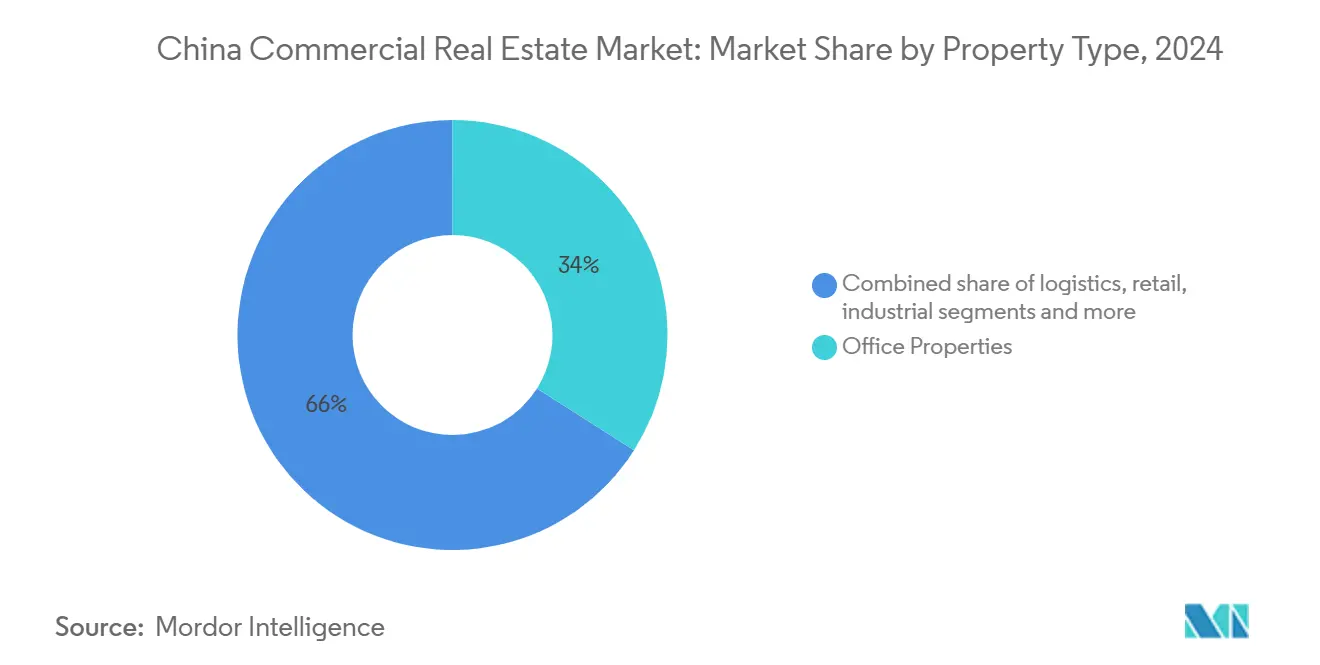
Note: Segment shares of all individual regions available upon report purchase
By Business Model: Sales Dominance Challenged by Rental Growth
Sales transactions accounted for 62.0% of market activity in 2024, mirroring a historic preference for upfront capital recovery and owner-occupier purchases. Presale frameworks facilitate cash-flow rotation, but regulatory curbs on escrow withdrawals compel developers to complete projects before accessing proceeds, tightening liquidity. Meanwhile, the rental business model is projected to expand at a 6.98% CAGR, energized by C-REIT exits and rising appetite among insurers and pension funds for bond-like real-estate income. This shift is visible in the China commercial real estate market size allocated to rental portfolios, which rose faster than presale receipts during 2024. [3]China Securities Regulatory Commission, “Questions & Answers on Public Infrastructure REITs,” CSRC, csrc.gov.cn
Developers are pivoting toward retain-and-operate strategies, often spinning stabilized malls or logistics parks into public REITs that recycle equity. Sale-leasebacks provide interim liquidity without relinquishing asset control. Professional property managers leverage IoT platforms to improve energy efficiency, boosting operating margins and net-asset valuations. The evolving blend of build-to-sell and build-to-hold options broadens exit routes and cushions developers against financing volatility. As rental exposure inches upward, income visibility becomes a pivotal credit metric across the China commercial real estate industry.
By End-user: Corporate Demand Stability Amid Individual Growth
Corporate and SME occupiers commanded 66.1% of floor take-up in 2024, anchoring cash flows with multi-year leases and stronger covenants. They continue to favor CBD offices, logistics hubs, and specialized R&D spaces, sustaining base demand regardless of consumer-cycle swings. SMEs increasingly request plug-and-play flexible suites, cultivating a secondary revenue line for landlords. Simultaneously, individual investors represent the fastest-growing end-user slice at a 6.73% CAGR, propelled by the democratization of REIT units and fractional-ownership apps regulated under new guidelines.
High-net-worth individuals diversify into strata offices and street-front retail as a hedge against residential-market cooling, while mass-affluent savers gain indirect exposure through mutual-fund channels. This broadening investor base introduces new liquidity pockets, though it heightens the need for transparent asset reporting and professional asset servicing. Institutional sponsors respond with investor-education campaigns and ESG-performance dashboards to retain trust. The deepening retail-capital pool is poised to mitigate funding volatility and inject resilience into the China commercial real estate market.
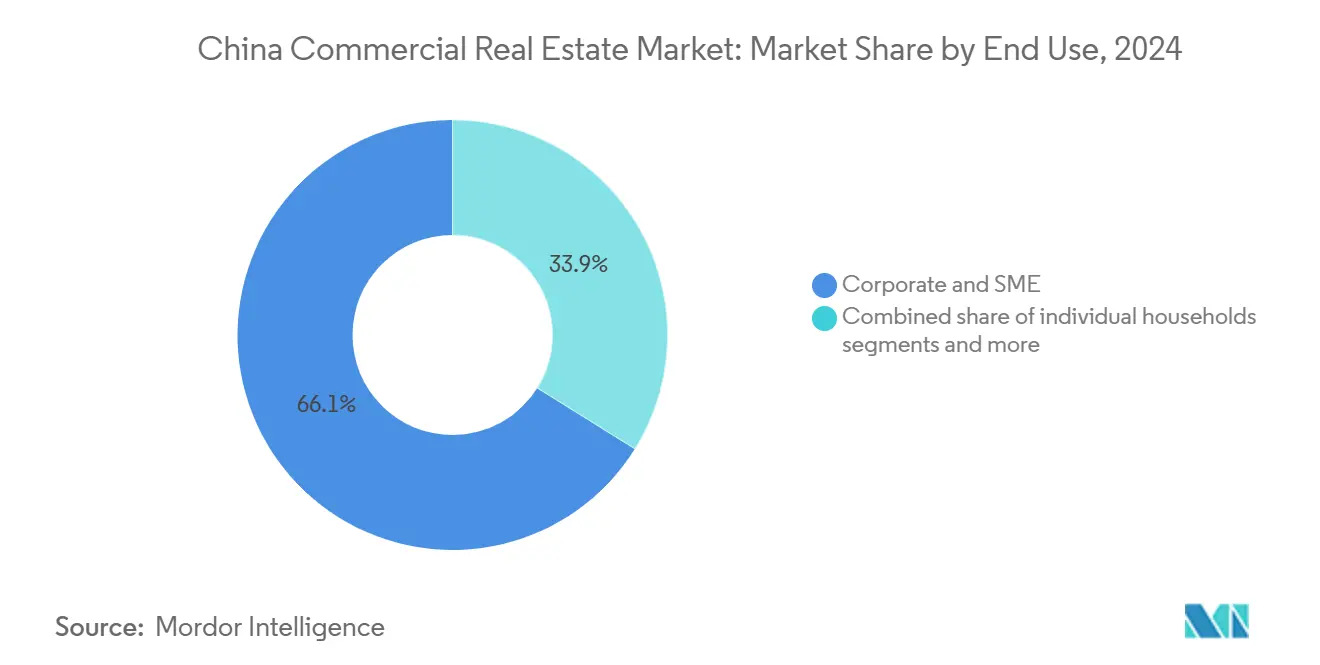
Note: Segment shares of all individual regions available upon report purchase
Geography Analysis
Shanghai retained its primacy with a 22% share of the China commercial real estate market in 2024, driven by USD 10.3 billion of office trades and an enduring magnetism for multinational tenants in finance and consulting. Grade-A vacancy remained below 8% as occupiers clustered in core Lujiazui and North Bund precincts that provide superior transit, green credentials, and high-speed data connectivity. Construction pipelines are shifting toward mixed-use waterfront revitalizations, often financed through C-REIT seeding that promises stable distributions.
Beijing follows as the policy and tech powerhouse, where Zhongguancun’s R&D demand offsets slower take-up in older CBD towers. Data-center campuses in northern Changping and south-west Daxing districts lure hyperscalers hungry for power capacity. Shenzhen’s Futian CBD and Qianhai cooperation zone maintain robust Grade-A absorption, aided by the Guangdong-Hong Kong-Macao Greater Bay Area plan that frames cross-border capital synergies. Guangzhou capitalizes on its port logistics and upgraded manufacturing base to maintain balanced office-retail-industrial demand.
Chengdu heads the growth league at a 7.24% CAGR toward 2030, lifted by national policies that encourage inland urbanization and the Chengdu–Chongqing twin-city economic circle. Modern warehouses near Chengdu’s Tianfu Airport command strong pre-leasing by third-party logistics operators, while emerging life-science parks attract biotech startups. Rising living-quality indicators entice talent migration, which further reinforces office demand. Investors prize Chengdu’s yield spread—often 150 basis points above Shanghai core CBD offices—yet benefit from improving liquidity as domestic insurers and fund managers increase western allocations. This dispersion of activity signals a healthier geographic balance for the China commercial real estate market.
Competitive Landscape
The China Commercial Real Estate Market is moderately fragmented, showcasing a dynamic and evolving competitive environment. Competition intensifies as financial troubles plague established giants, favoring nimble, operationally adept players. China Vanke booked a USD 6.97 billion loss for 2024, its first since 1991, after revenue fell to USD 48.34 billion under deleveraging stress. Similar headwinds pressure other traditional developers, some of whom divested non-core holdings at discount valuations—ESR Group’s USD 0.82 billion logistics asset sale and Sino-Ocean’s USD 0.56 billion mall exit typify strategic pruning. Consolidators with strong balance sheets absorb distressed stock, while opportunistic funds negotiate preferred-equity injections in stalled projects.
Institutional investors and asset managers are seizing the moment. Longfor Group, for instance, raised rental revenue to USD 3.76 billion in 2024 despite headline sales softness, underscoring the durability of its hold-and-operate platform. Foreign core-plus funds broaden stakes in logistics and data-center joint ventures, aided by Stock Connect-enabled C-REIT access that sidesteps earlier quota constraints. Technology deployment—IoT sensors, AI facility analytics, tenant engagement apps—has become a differentiator in winning blue-chip leases and reducing operating cost ratios.
Strategic plays increasingly revolve around value-add refurbishments, green repositioning, and thematic assets like life-science parks. Developers collaborate with energy-service companies to install renewable micro-grids, boosting 3-Star green-building scores and unlocking cheaper sustainability-linked loans. Cross-industry partnerships are also visible: logistics operators integrate last-mile solutions into vacant big-box retail, while data-center operators retrofit high-floor-loading industrial shells. With capital chasing fewer bankable sponsors, those able to combine execution prowess, ESG credentials, and transparent governance will consolidate influence across the China commercial real estate market.
China Commercial Real Estate Industry Leaders
Wanda Group
China Resources Land Ltd
Greenland Group
Longfor Group
China Vanke Co.
- *Disclaimer: Major Players sorted in no particular order
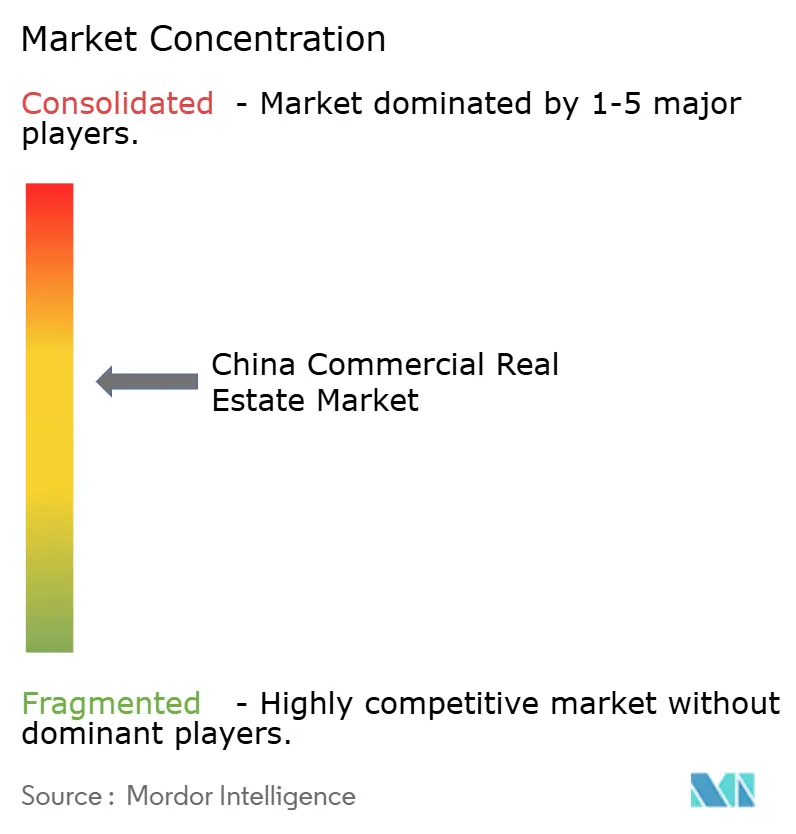
Recent Industry Developments
- April 2025: China Vanke posted a USD 6.97 billion loss for 2024 on USD 48.34 billion revenue as deleveraging curtailed margins.
- March 2025: Longfor Group reported USD 17.95 billion 2024 revenue; investment-property income rose 7.4% to USD 3.76 billion.
- January 2025: Sinotrans applied to spin off a warehouse logistics C-REIT on Shanghai Stock Exchange, extending C-REIT coverage to logistics infrastructure.
- October 2024: China’s housing ministry unveiled a USD 563.4 billion funding uplift to stabilize project deliveries.
Research Methodology Framework and Report Scope
Market Definitions and Key Coverage
Our study treats China's commercial real estate (CRE) market as all income-generating property, office, retail, logistics, hospitality, data center, life science, and mixed-use assets traded or leased within mainland China, with value expressed in U.S. dollars at transaction date exchange rates.
Scope Exclusion: Residential housing and land bank transactions held only for future development are outside this remit.
Segmentation Overview
- By Property Type
- Offices
- Retail
- Logistics
- Others (industrial, hospitality, data-centre, life-science, mixed-use)
- By Business Model
- Sales
- Rental
- By End-user
- Individuals / Households
- Corporates & SMEs
- Others (institutions, governments, NGOs)
- By Cities
- Shanghai
- Beijing
- Shenzhen
- Guangzhou
- Chengdu
- Rest of China
Detailed Research Methodology and Data Validation
Primary Research
Analysts interview institutional investors, lenders, property managers, and occupiers across Tier 1 to emerging inland cities. Discussions test desk assumptions on cap rate shifts, lease tenures, C-REIT pricing, and brown to green retrofit costs, letting us reconcile diverging data and refine discount factors.
Desk Research
We begin by pulling macro signals from sources such as the National Bureau of Statistics, the People's Bank of China financial stability reports, and MOHURD construction starts bulletins; these frame investment flows, vacancy, and price movements. Cross-border trade data from China Customs clarifies logistics footprint growth, while Shanghai and Shenzhen stock exchange filings enrich developer balance sheet analysis. Paid repositories, D&B Hoovers for developer revenue splits and Dow Jones Factiva for transaction news, supply hard to find deal values. The sources named illustrate, not exhaust, the wider set we review.
Market-Sizing & Forecasting
A top down build marries transaction value by property class with city level absorption, then overlays vacancy and average selling price curves to establish the baseline. Select bottom up cross checks, sampled Grade A stock multiplied by prevailing rents and pipeline completions, calibrate totals. Key drivers in the model include GDP growth, office net absorption, warehouse take up, policy induced C-REIT issuances, and prime yield spreads. Multivariate regression projects each driver, generating a future value. Gaps in sub-segment data are bridged by interpolating adjacent year disclosures or weighting peer city analogs vetted with interviewees.
Data Validation & Update Cycle
Outputs undergo variance scans against MSCI professionally managed stock, CBRE quarterly investment tallies, and central bank lending series. Senior analysts review anomalies before sign off. We refresh figures annually and issue interim updates when policy or capital market shocks exceed preset thresholds.
Why Our China Commercial Real Estate Baseline Commands Reliability
Published estimates often differ; choices on scope, exchange rates, and refresh cadence typically explain the gaps.
Key gap drivers here include whether residential build to rent is folded into totals, if estimates cover only professionally managed assets, and the year each firm locks FX rates. Mordor's model aligns segments with actual CRE investor behavior, applies city specific vacancy haircuts, and rolls 12 month RMB averages forward each quarter; practices some peers omit.
Benchmark comparison
| Market Size | Anonymized source | Primary gap driver |
|---|---|---|
| USD 0.86 T (2025) | Mordor Intelligence | - |
| USD 962 B (2024) | Global Consultancy A | Counts only professionally managed portfolios, omits owner occupied assets |
| USD 860 B (2024) | Regional Consultancy B | Uses transaction price database but excludes logistics conversions and data centers |
| USD 217 B (2024) | Industry Analytics C | Reports investment volume, not full asset value; narrower tech centric scope |
These comparisons show that when definitions narrow or value proxies shift, totals swing widely. By anchoring on full income generating stock, rolling quarterly FX, and cross verifying with both desk and field intelligence, Mordor delivers a transparent, repeatable baseline clients can trust.
Key Questions Answered in the Report
What is the current size of the China commercial real estate market?
It was valued at USD 855.26 Billion in 2025 and is projected to reach USD 1,161.36 billion by 2030.
Which property type holds the largest share in the China commercial real estate market?
Office assets commanded 34% of total value in 2024, maintaining their leadership position.
Which segment is growing fastest within the China commercial real estate market?
Logistics real estate is forecast to expand at a 7.72% CAGR through 2030, powered by e-commerce and supply-chain upgrades.
Why are C-REITs important for the China commercial real estate market?
They unlock institutional equity, diversify funding beyond bank loans, and offer investors liquid exposure to income-earning properties.
Which city shows the highest growth potential?
Chengdu is projected to record a 7.24% CAGR to 2030, spurred by western development policies and transport-hub expansions.
How is hybrid work affecting office demand?
Hybrid adoption is raising vacancy in legacy towers, but Grade-A upgrades remain in demand, intensifying the quality gap across the office landscape.
